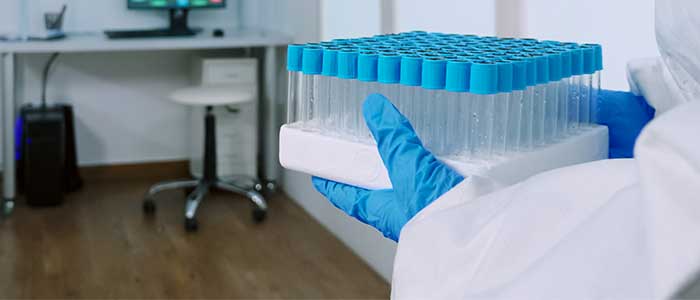
What is sterilization? What does it mean when something is said to be "sterilized?"
As defined by the CDC, sterilization is a process that destroys or eliminates all microbial life on the surface of an article or in a fluid to prevent disease transmission associated with using that item.
.png)
Why is sterilization so important? Sterilization is vital in ensuring that harmful and infectious microorganisms or pathogens are not transmitted to whatever comes in contact with that item. Whether we know it or not, sterilization plays a prominent role in all our lives. Medical devices, surgical or dental tools, needles, syringes, and sutures are some examples of sterilized items. While sterilization is essential to the medical industry, it is also crucial in laboratories.
Labs worldwide utilize sterilization every day to conduct successful research and experiments. Some of the most commonly sterilized items in a lab are:
- Beakers
- Flasks
- Graduated cylinders
- Water
- Cell growth media
- Pipette tips
- Glass pipettes
- Agar
- Petri dishes
- Glass test tubes
- Plastic tubes (centrifuge, conical)
If these items are not sterilized and sterilized correctly, data collected during experiments may be skewed and inaccurate, causing incorrect conclusions to be drawn.
There are several different sterilization methods, including,
But steam sterilization is one of the most efficient, safest, and inexpensive solutions available. Steam sterilizers, also known as autoclaves, expose each load item to direct steam contact at the required temperature and pressure for a specified time. Sterilization times vary based on the item(s) being sterilized (plastic, liquids, metal, garments, etc.) and other factors, such as whether the items are wrapped or unwrapped. The most common temperatures for steam sterilization are 121°C and 134°C. These temperatures must be maintained for the proper amount of time to achieve successful sterilization.
Most Common Types of Autoclaves
The two most common types of autoclaves are gravity displacement autoclaves and pre-vacuum autoclaves ranging from horizontal benchtop units to vertical units to large-scale industrial units. These units can either be manually or electronically controlled. With manual autoclaves, each stage of the sterilization cycle is controlled by a user manually. With electronic autoclaves, each step of the sterilization cycle is controlled and automated via the unit's control system. For successful sterilization, removing the air from within the chamber is important because air prevents steam penetration. Both gravity displacement and pre-vacuum autoclaves do this but in different ways.
Gravity Displacement Autoclaves
In gravity displacement autoclaves, steam is admitted to the autoclave chamber. Because steam is lighter than air, it can force out the air within the chamber through exhaust valves to allow for successful sterilization. Gravity displacement autoclaves are primarily used for media or liquids, wrapped or unwrapped items, autoclavable plastics, laboratory waste, and glassware.
Pre-Vacuum Autoclaves
Pre-vacuum autoclaves utilize a vacuum system to remove all ambient air in the autoclave before steam is introduced to the chamber, allowing for faster cycle times. Because of this, they can be used for more porous loads such as garments, tubing, gloves, syringes, textiles, and any items with small openings where removing air may be difficult.
Liquid Sterilization
Over the years, lab autoclave users have been limited to using autoclaves designed for medical and dental office applications such as those mentioned previously (surgical and dental tools, medical devices, syringes, etc.). Their limited functionality has left laboratory autoclave users unable to meet their everyday growing lab needs. One of those ever-increasing needs is the ability to sterilize liquids properly. Liquid sterilization is one of the most common applications for laboratory autoclave users. When sterilizing liquids, the temperature of the liquid must be monitored directly to ensure that it reaches the correct sterilization temperature for the proper amount of time. The autoclave must have a temperature monitoring device, such as a temperature probe, to achieve this. This probe can be placed into the liquid to monitor and control its temperature throughout the sterilization cycle. Without this feature, the unit will monitor the temperature of the chamber rather than the liquid itself. Since liquids heat at a slower rate than the chamber, they may not be appropriately sterilized.
This content is hosted by a third party (youtube.com). To view external content you must agree to cookies.
Heidolph's Lab Line Autoclaves
Heidolph's Lab Line (EL) autoclaves are designed to meet all your laboratory sterilization needs.
The base EL models with two integrated temperature probes ensure the sterilization of liquids. The fully equipped ELC-PVG models (with a steam generator "G" for quick heat up, cooling coils "C" to reduce liquid cooling time by up to 75%, and a vacuum pump "PV" to eliminate trapped air) give you the full functionality of a large autoclave that can fit in your lab. The operating software adds additional functionalities with endless possibilities. You can create custom cycles, store up to 200 past cycles, trace and record user interactions with our 21 CFR software, sterilize sealed bags with our overpressure cycle, and much more.

Heidolph Tuttnauer Autoclaves provide a fast, safe, dependable, and convenient way to sterilize liquids, media, instruments, glassware, clothing, and hazardous waste.
Contact your Thomas Representative today to learn more about how Heidolph's autoclaves can meet your laboratory sterilization needs.